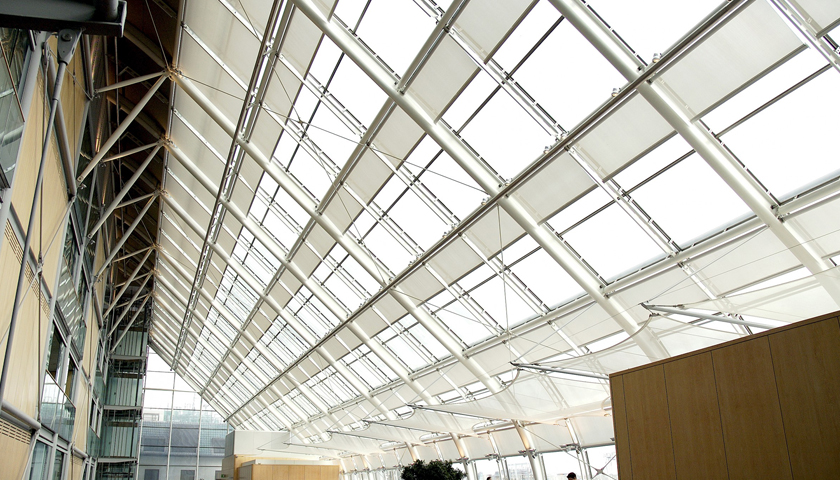The Wellcome Trust’s impressive London headquarters, the Gibbs Building, is an outstanding piece of architecture; an award-winning 28,000m2 glass and steel structure that befits the status of the world’s biggest medical research charity.
Designed by Hopkins Architects, it comprises a high, wide block facing Euston Road, one of the capital’s busiest roads, with a lower block on the south side. Over both is a beautiful, angled and curved glazed roof.
Shading engineering experts Guthrie Douglas were asked to design and produce an effective shading system for the glazed south-side roof, above the restaurant area, to help minimise the need for air conditioning and also to protect staff from heat and glare all year round.
As a pioneer of innovative interior and exterior shades for even the most complex of buildings, Guthrie Douglas engineers use their in-depth knowledge to create bespoke systems that work for a specific space.
This scheme was no exception. The leader in technical shading systems recommended its unique and versatile TESS™ 100, the guideless rectangular system that is designed for all curved applications, each with a width of 2.8 metres.
Engineers developed for the Wellcome Trust project relieving rollers and tensioned guide wires for the blinds that were fitted on the double-skinned glazed façade, creating a fully automated solar shading system.
These rollers and guides ensure that the fabric remains fully and closely aligned with the curved glazed envelope above, and that the systems are deployed in unison, accurately.
Andrew Kitching, Managing Director of Guthrie Douglas, says: “Great design is often about what you can’t see. The earlier we are involved in the design process, the easier it is to conceal the mechanisms and wiring that are required for an automated shading system, especially for large-scale projects like this one.”
To create seamless, unbroken lines in the Gibbs Building shading system, the electrical cables for the solar sensors were hidden in the steel trusses of the building and within flexible stainless steel conduits. The expanse of glass that required shading meant a fully automated system was the most sensible and user-friendly option, making sure that people in the roof restaurant can stay as comfortable as possible – even on the hottest of days.
As the sun passes overhead and light levels exceed a set threshold, the blinds are activated automatically as a group. This maintains optimum protection throughout the day, to control light and glare, and to prevent excessive solar heat gain.
“Our engineers never shy away from technological challenges, and are always seeking the most innovative and best way to deliver shading projects for our clients,” adds Andrew. “The Wellcome Trust building presented us and our installation partners with a number of difficult aspects to overcome and I’m delighted at the outcome.”
The TESS™ 100 system is ideal for overcoming the toughest challenges on curved glazing, while maintaining a stylish and effective look. Suitable for fabric areas of 16m2 of under, it is available in widths of 870mm – 4000mm, unlimited colour finishes and a wide range of fabrics, making it suitable for any project.
Guthrie Douglas products are found in challenging climates such as the Middle East and northern Scandinavia and its exterior blind systems are manufactured with an inherently strong tension mechanism that holds fabric tight even in extreme temperatures and strong winds. They also meet the stringent European Norms under the Construction Related Products regulations (CPR) and all have mandatory CE marking, which was introduced in June 2013.


